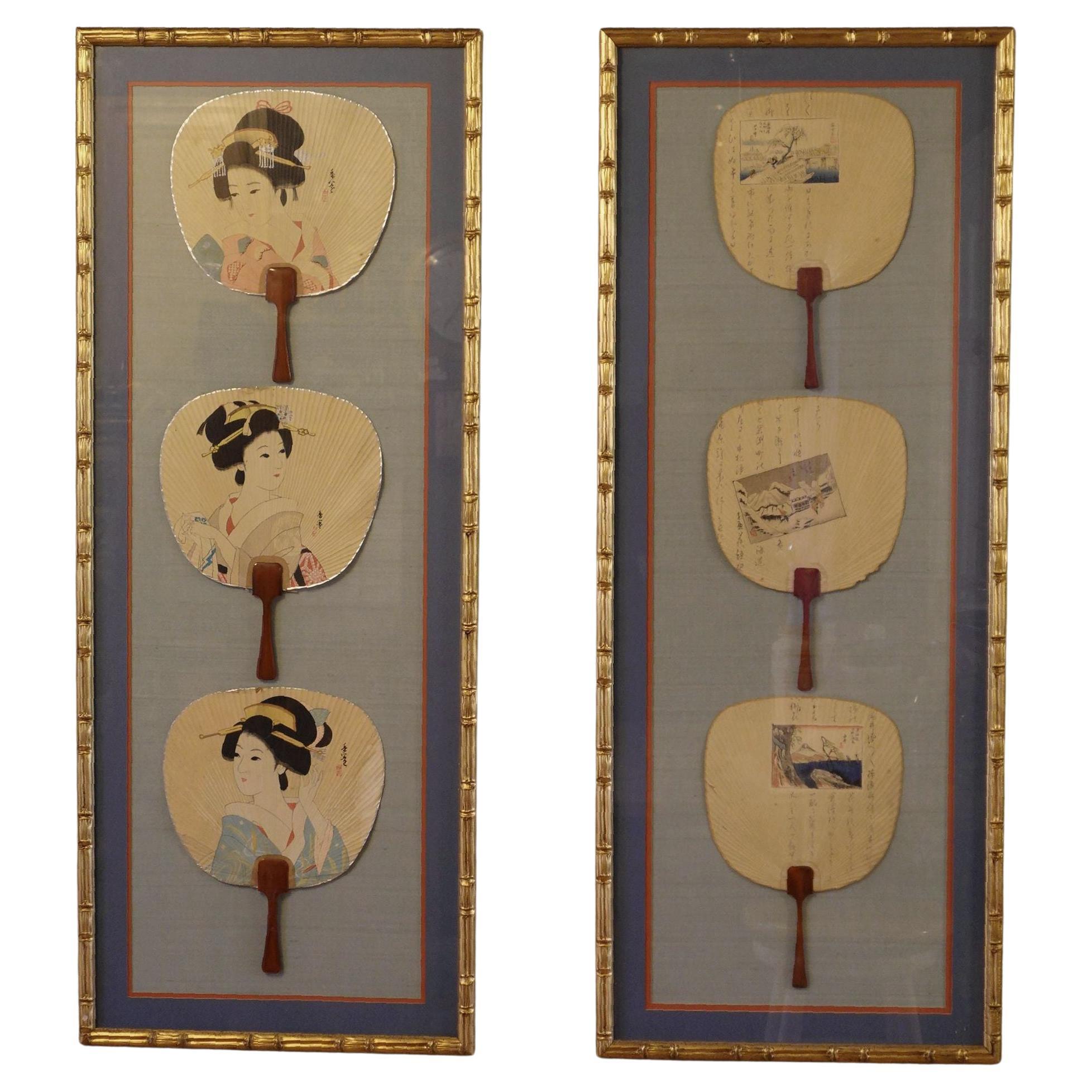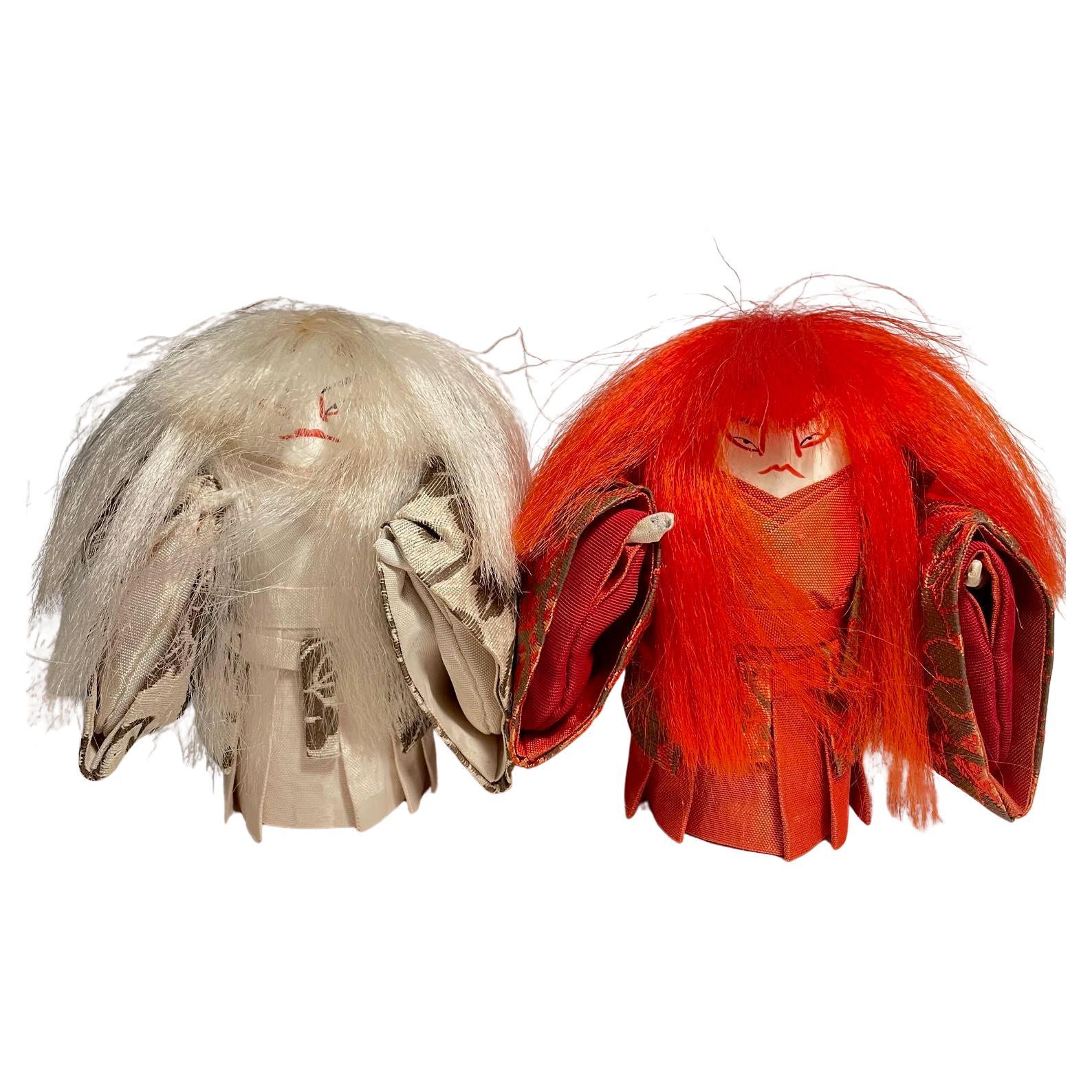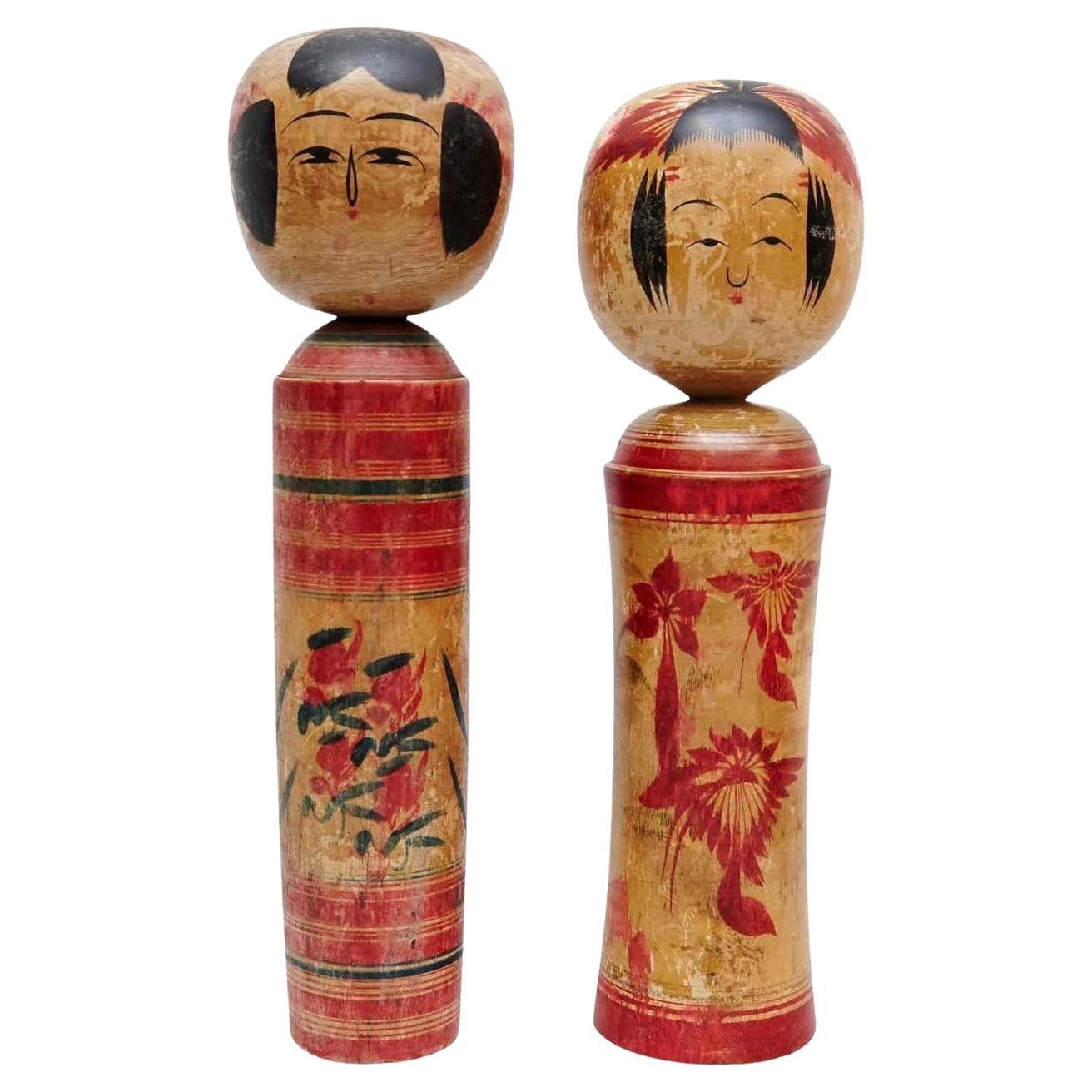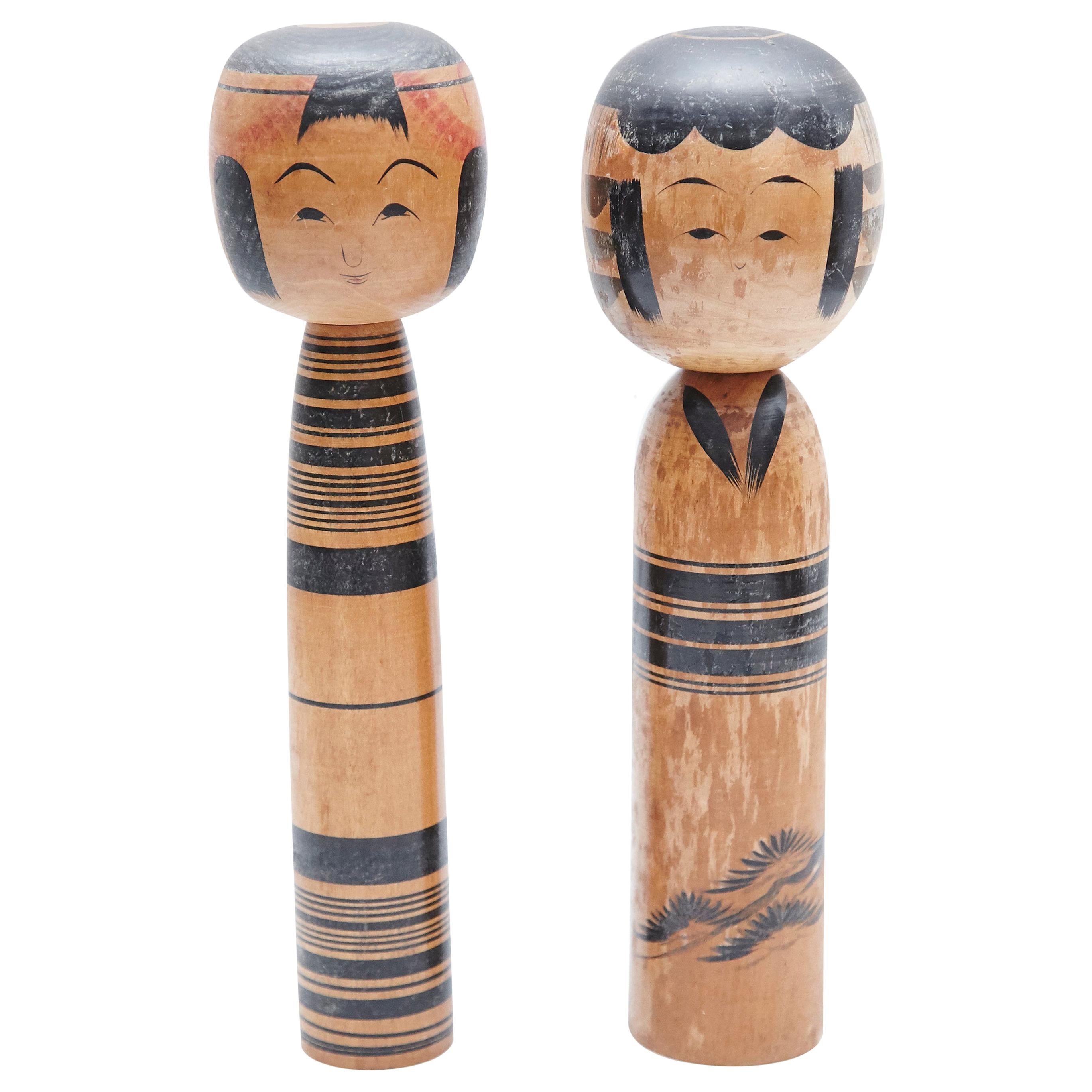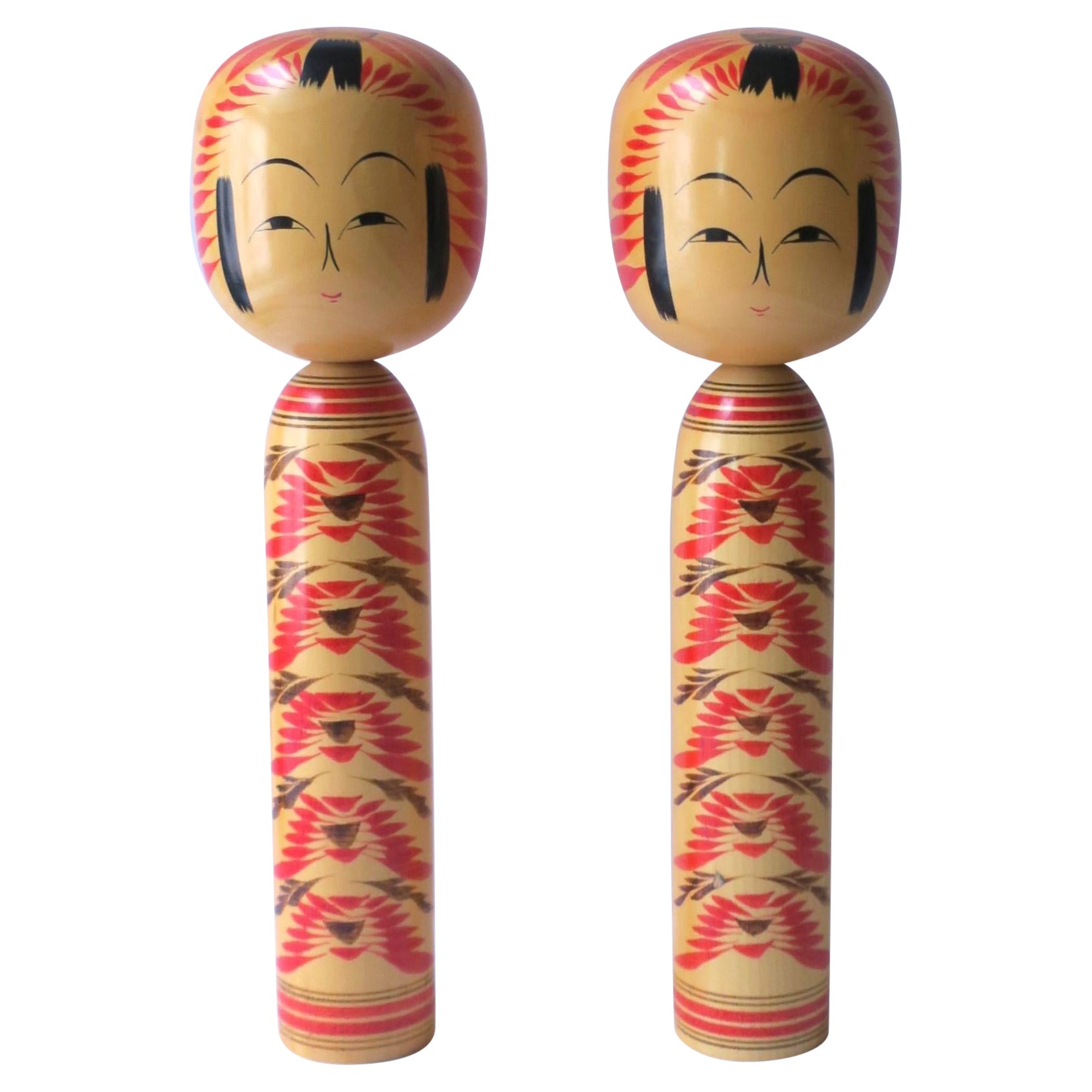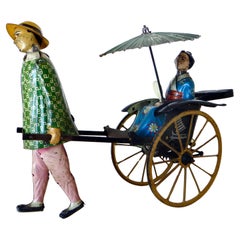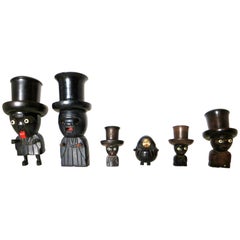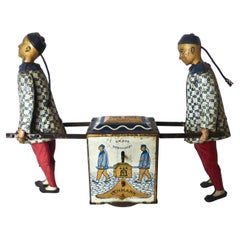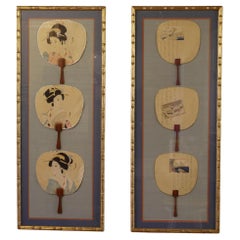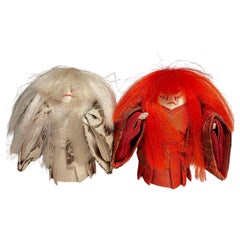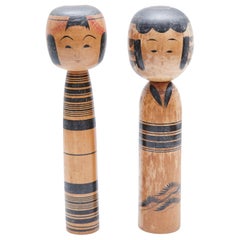Items Similar to Two Post War Kabuki Paddles (Hagoita) Original Shuttlecock Ball Japan Circa 1960
Want more images or videos?
Request additional images or videos from the seller
1 of 17
Two Post War Kabuki Paddles (Hagoita) Original Shuttlecock Ball Japan Circa 1960
$400
£305.39
€349.78
CA$560.40
A$626.59
CHF 328.67
MX$7,589.55
NOK 4,148.87
SEK 3,919.68
DKK 2,610.74
About the Item
Offered are a pair of post war Japanese Kabuki paddles circa 1960, featuring a male and female Kabuki character actors in full traditional Japanese regalia with weapon mounts in hand. Also included is the original shuttlecock ball which is super rare to find! Material is fabric (probably cotton) on wood with hand painted floral themes to the reverse side (see images); handles are wrapped in felt. The paddles are in excellent and all original condition, and would have been used to play Hanetsuki (probably pickle ball today!!). This was a traditional Japanese game played at the New Year and would have entailed using these elaborate three dimensional looking paddles, called Hagoita, to smash and bat away shuttlecocks or "hanes" (brightly colored round balls) to ward off evil spirits. The custom dates back to the early 17th century Edo period in Japan.
The paddles are intricately and well made; hand crafted with much attention to detail. Unique to find in this larger size and quality, and to find as a pair, especially as a couple. As stated previously, so hard to find the original "hane" (ball)----see images. Suitable for hanging on the wall to display if desired.
Dimensions:
Female character is: 24" high x 9" wide (tapers down to the handle) x 3" deep
male character is 21" high x 7 3/4" wide (tapers down to the handle) x 2 1/2" deep
Shuttlecock ball is felt covered hard rubber 2 1/2" diameter
Provenance: Acquired recently from a San Francisco estate
- Dimensions:Height: 24 in (60.96 cm)Width: 9 in (22.86 cm)Depth: 3 in (7.62 cm)
- Style:Mid-Century Modern (Of the Period)
- Materials and Techniques:
- Place of Origin:
- Period:
- Date of Manufacture:Circa 1960
- Condition:
- Seller Location:Incline Village, NV
- Reference Number:1stDibs: LU973238919952
About the Seller
5.0
Recognized Seller
These prestigious sellers are industry leaders and represent the highest echelon for item quality and design.
Gold Seller
Premium sellers maintaining a 4.3+ rating and 24-hour response times
Established in 1976
1stDibs seller since 2013
277 sales on 1stDibs
Typical response time: 1 hour
Associations
Art Dealers Association of America
- ShippingRetrieving quote...Shipping from: Incline Village, NV
- Return Policy
Authenticity Guarantee
In the unlikely event there’s an issue with an item’s authenticity, contact us within 1 year for a full refund. DetailsMoney-Back Guarantee
If your item is not as described, is damaged in transit, or does not arrive, contact us within 7 days for a full refund. Details24-Hour Cancellation
You have a 24-hour grace period in which to reconsider your purchase, with no questions asked.Vetted Professional Sellers
Our world-class sellers must adhere to strict standards for service and quality, maintaining the integrity of our listings.Price-Match Guarantee
If you find that a seller listed the same item for a lower price elsewhere, we’ll match it.Trusted Global Delivery
Our best-in-class carrier network provides specialized shipping options worldwide, including custom delivery.More From This Seller
View AllEarly Hand Held Fan "Mount Fuji". Japanese Circa 1870
Located in Incline Village, NV
Late 19th century fine quality Japanese hand held lady's fan for keeping cool; hand painted on silk with hand carved bone frame, floral leaf and fret work design; with 18 sticks in a...
Category
Antique 1870s Japanese Victorian Decorative Art
Materials
Silk
Vintage "Masuyama" Lehman Wind-Up Toy. German, Circa 1913 Rare
By E.P. Lehman Co.
Located in Incline Village, NV
Early 1900's German hand painted and lithographed tin wind-up toy, by premier tin and whimsical toy maker, Ernest Paul Lehman, circa 1913. This charming and unique toy portrays a Ja...
Category
Vintage 1910s German Folk Art Toys and Dolls
Materials
Tin
Six Kobe Toys, Japanese, Meiji Period, circa 1895
By Kobe Toys
Located in Incline Village, NV
Kobe Toys are very mysterious and not much is known about them. They were created and hand made, strictly for tourists and foreigners (never exported) during ...
Category
Antique 1890s Japanese Folk Art Toys
Materials
Ebony
"Kadi" Pre-war Wind-Up Toy by Lehman Company. Germany Circa 1905
By E.P. Lehman Co.
Located in Incline Village, NV
"Kadi" is the name of this rare Chinese themed vintage German made mechanical toy; depicting two turn of the century Chinese men with pigtails walking along, while carrying a large t...
Category
Antique Early 1900s German Folk Art Toys and Dolls
Materials
Tin
Vintage "Fancy Japanese Lady" Doll Head Vase, American, Circa 1958 Scarce
Located in Incline Village, NV
Hard to find and much sought after head vase; manufactured by the Tacoma Pottery Company (U.S.A.), circa late 1950's; depicts Japanese young lady dressed in formal traditional Japane...
Category
Mid-20th Century American Mid-Century Modern Busts
Materials
Porcelain, Ceramic
Early 19th Century American Double Sided Games Board
Located in Incline Village, NV
Very early American wooden games board; probably the oldest I have handled, this dates to about circa 1835 and exhibits the markings of a typical cottage industry type manufacture (not unlike very early Noah's Arks). Obviously entirely hand crafted; measurements are not exactly square (left to right; top to bottom), probably made of a local soft wood, and hand painted with squares not perfectly delineated. Black light and "loop" inspection reveals age crazing and original paint that, in conjunction with original wear and no attempt to touch up, dates it to the early 19th century. Most definitely American, as the last thing an English immigrant would have brought to America at that time would have been a game.
When closed, or in the folding position, the board game simulates and is made to look like two books resting side by side (see images), and thusly, was made to sit on a book shelf, either horizontally or vertically; and to be pulled out to play games when desired, which would have been either the game of checkers (draughts), chess, or backgammon. The board opens up to a two sided game option. On one side is the proverbial 64 square (English/ American version) of chess or checkers; and on the other side is a backgammon board. Both sides are hand painted in gold and black, with a rust colored border around the checkerboard. The interior backgammon play area is also black and gold with the same color rust area to the central part. Nail hinges in the center frame, pivot the two sides to open, while a leather covering borders the edge trim, which is 50% lacking on the hinge side. I state the condition to be good, considering it's age, it's use, and the fact that it is still very "usable" and, if taken care of, will probably continue to be so for nearly another 200 years!
The checkers, (12) black pieces and (12) yellow (the correct numbers) are hand carved in wood and hand painted. The backgammon pieces (stored in period wooden box) contain 14 yellow hand painted and carved pieces and (13) black ones. (15) of each color are used to play backgammon (simply use the checkers, which are just about the same size (see images) to make up the difference. Most antique game boards...
Category
Antique 1830s American Folk Art Game Boards
Materials
Wood
You May Also Like
Antique 19th Century Framed Japanese Silk Fans
Located in Norton, MA
Antique 19th century Framed Japanese Silk Fans comprising two attractively framed Japanese silk fans, one group with 3 Geishas, the other scenic with...
Category
Antique Early 19th Century Japanese Prints
Materials
Silk, Wood
$2,725 / set
Japanese Two Wooden Kabuki Dolls Renjishi 1990s
Located in Paris, FR
They are two Kabuki (Japanese theater) dolls made with woods and silk.
The woods are for body parts and silks are for kimono parts that they are wearing.
These dolls are from Renjishi Story.
They were made in Japan around 1990s in Showa era.
Dimensions:
8.5 × 6.5 x H9.5 cm (White kabuki doll...
Category
1990s Japanese Showa Antiquities
Materials
Silk, Wood
Set of Two Mid Century Modern Hand Painted Wood "Kokeshi" Dolls
Located in Barcelona, ES
Japanese dolls called Kokeshi of the early 20th century. Provenance from the northern Japan. Set of 2. Measures: 37 x 10.5 cm 36 x 11 cm Handmade by Japanese artisants from wood...
Category
Early 20th Century Japanese Edo Sculptures and Carvings
Materials
Wood
$582 Sale Price / item
44% Off
Set of 2 "Kokeshi" Dolls
Located in Barcelona, ES
Japanese dolls called Kokeshi of the early 20th century. Provenance from the northern Japan. Set of 2. Measures: 24.5 x 7 cm 25 x 6.5 cm Handmade by Japanese artisants...
Category
Early 20th Century Japanese Edo Sculptures and Carvings
Materials
Wood
$569 Sale Price / item
76% Off
Japanese Kokeshi Wood Dolls, Signed, Pair
Located in New York, NY
A pair of authentic signed Japanese Kokeshi wood dolls, circa mid-20th century, Japan. Dolls shapes and patterns are particular to a certain area and are classified under eleven type...
Category
Mid-20th Century Japanese Edo Figurative Sculptures
Materials
Wood
Japanese Noh/Kabuki Shakkyo painting, Torii Kiyotada
Located in Point Richmond, CA
Japanese colors, gofun and metallics on silk painting of Noh/Kabuki Dancers, depicting two figures of actors dancing in the play Shakkyo portraying a pair of shishi (lions), one on a...
Category
Early 20th Century Japanese Meiji Paintings and Screens
Materials
Silk
More Ways To Browse
Post War Modern Furniture
Midcentury Modern Textile Art
Japanese Fabric Art
Vintage Felt Fabric
Japanese Wall Fabric
Painted Paddle
Wood Paddle
Vintage Rubber Ball
Vintage Rubber Balls
Middle Eastern Kaftan
Qing Dynasty Robe
19th Century Chinese Silk Embroidery
Thai Silk
Framed Chinese Robe
Silk Obi
Chinese Silk Robe
Qing Dynasty Textile
Antique Chinese Silk Embroider
